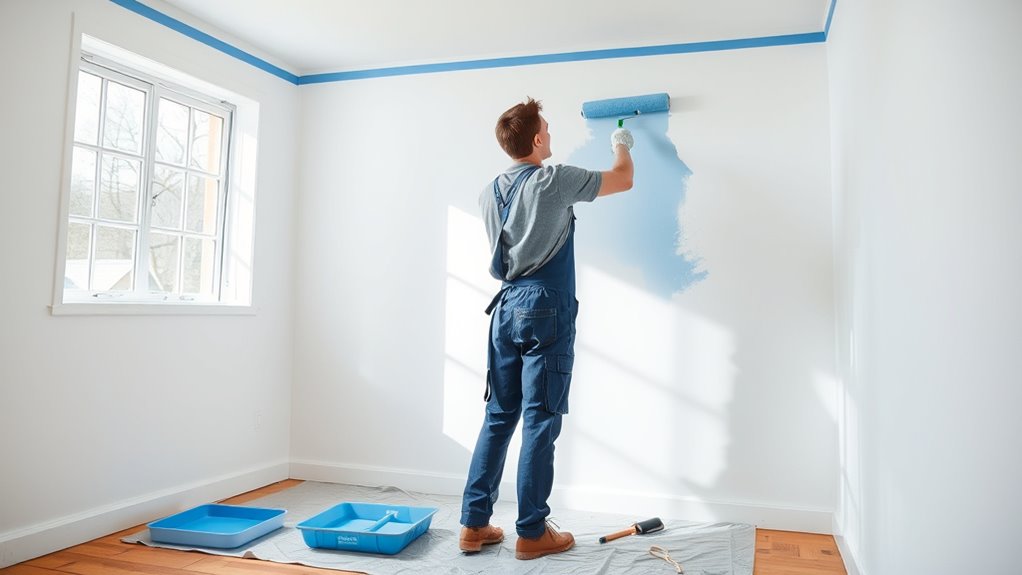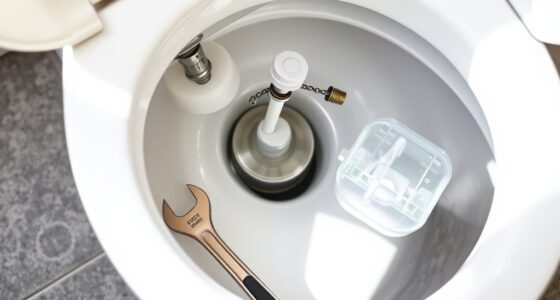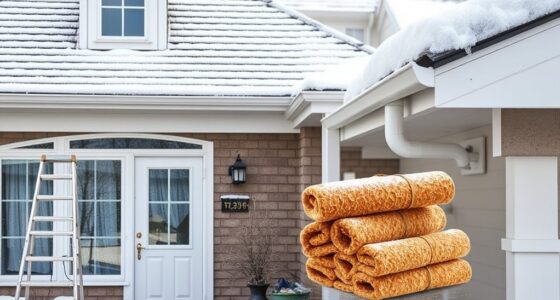To paint a room like a pro, start with thorough surface prep by cleaning walls and using painter’s tape for edges. Use quality brushes and rollers, loading them properly to avoid drips, and work in small sections for smooth, even coverage. Begin with ceilings, then move to walls, blending each section while wet to prevent streaks. For crisp lines, remove tape promptly. If you keep these tips in mind, you’ll soon achieve professional results—and there’s more to discover to perfect your skills.
Key Takeaways
- Prepare surfaces thoroughly by cleaning, priming, and masking edges for smooth, professional results.
- Use proper tools like angled brushes and rollers with even paint loading for precise application.
- Start with ceilings and work in small sections to ensure even coverage and avoid lap marks.
- Apply multiple coats if needed, allowing each to dry completely for a durable finish.
- Finish by removing painter’s tape immediately and inspecting for touch-ups to achieve sharp, clean lines.

Getting started with painting can seem overwhelming, but with the right preparation, you’ll achieve professional-looking results. First, select high-quality brushes and rollers. Good tools make a big difference, helping you apply paint smoothly and evenly. Before you start, clear the room of furniture and cover the floors with drop cloths to protect them from splatters. Clean the walls thoroughly to remove dust and dirt, which helps the paint adhere better and results in a more durable finish. If needed, apply a primer to create a smooth, uniform surface that enhances paint coverage and color richness.
Start your painting project with quality tools, thorough prep, and proper surface treatment for professional results.
Next, tape off trim, edges, and any areas you want to keep paint-free. Use painter’s tape for clean lines and to protect surfaces from accidental splashes. When it’s time to load your brushes, dip them about two fingers deep into the paint, then wipe off the excess to prevent drips. When applying paint with a brush, drag it smoothly along the surface to avoid pooling, which can cause uneven texture. Use an angled brush to cut in along edges, corners, and trim, painting about six inches inward from the tape line. This technique ensures sharp, straight edges and reduces the need for additional coats. Remove the tape immediately after painting while the paint is still wet to prevent tearing or peeling.
For rolling, use a “W” or zigzag pattern to distribute paint evenly across the wall. Divide large surfaces into sections about three to four feet wide, painting each one thoroughly before moving on. While the paint is wet, blend each section into the next to prevent lap marks. Extend your roller with a pole for high ceilings or hard-to-reach areas, and work in small sections to guarantee consistent coverage. When painting ceilings, start there to avoid drips on your freshly painted walls. Afterward, paint the walls using the same technique, then finish with trim and edges last for a polished look. Remember that choosing the right paint type can make a significant difference in the final appearance and durability of your project.
If necessary, apply a second coat once the first coat dries completely. Use high-quality paint for better durability and color richness, and stir it thoroughly before use to guarantee uniformity. For color consistency, mix all cans into a single container if possible.
Safety is essential. Ensure proper ventilation, wear gloves and goggles to protect your skin and eyes, and keep tools away from electrical outlets. Use drop cloths to guard floors and furniture from spills. Avoid painting in direct sunlight or extreme temperatures to prevent issues with paint drying and adhesion.
Finally, inspect your work, make any touch-ups, and carefully remove the painter’s tape. Clean your brushes and rollers immediately after finishing. If needed, apply additional coats, always allowing the previous layer to dry completely. With patience and attention to detail, you’ll transform your space with a professional finish that’s hard to beat.
Frequently Asked Questions
How Do I Choose the Right Paint Finish for My Room?
When choosing the right paint finish, consider your room’s purpose and traffic level. For bedrooms, go with flat or eggshell for a subtle look. In kitchens and bathrooms, satin or semi-gloss work best for durability and easy cleaning. Think about light reflection and imperfections—higher sheens make colors pop but show flaws. Match the finish to your style and maintenance needs, ensuring your space looks great and stays practical.
What Are the Best Tools for Detailed or Intricate Painting?
For detailed, delicate designs, immerse yourself in a diverse toolkit. Use precise paint edgers to expertly enclose edges, while nimble natural or synthetic brushes tackle tiny trims and intricate details. Sprayers deliver smooth, swift coverage on complex surfaces. Masking tape masters sharp, clean lines, and painting knives smooth putty or spackle. With these tools, you’ll transform tricky territories into perfectly polished, professional-looking masterpieces, making your painting process precise, practical, and profoundly satisfying.
How Can I Prevent Paint From Dripping or Splattering?
To prevent paint from dripping or splattering, start by choosing the right tools, like rollers with appropriate nap lengths and brushes with proper stiffness. Pour paint into a tray to control application, and tap off excess before applying. Use slow, controlled strokes, avoid overloading your brush or roller, and maintain consistent paint thickness. Cover floors and furniture with plastic, tape edges, and clean surfaces thoroughly to minimize messes during your project.
What’s the Ideal Temperature and Humidity for Painting?
You want to know the ideal temperature and humidity for painting. Keep the temperature between 50°F and 90°F, depending on your paint type, and aim for a consistent environment to avoid issues like blistering or peeling. Maintain humidity levels between 40% and 60%, using tools like humidifiers or air conditioners if needed. Check the weather forecast, and try to paint during late morning or early afternoon for best results.
How Do I Fix Mistakes or Uneven Paint Spots?
To fix mistakes or uneven paint spots, start by cleaning and sanding the area smooth. Carefully shave off drips or runs with a razor blade, then sand to blend. Lightly reapply paint with a brush or roller, feathering the edges to match surrounding areas. Use thin coats, avoid overloading your brush, and let each layer dry completely. Re-sand if needed, and blend seamlessly for a flawless finish.
Conclusion
Now that you’ve got these painting tips under your belt, you’re all set to give your room a fresh new look. Remember, even the pros started somewhere, and a little patience goes a long way. Don’t worry if things aren’t perfect at first—your space will beautifully reflect your effort and creativity. Before you know it, you’ll be enjoying a professionally finished room, and your confidence will be shining just as bright as your walls. Happy painting!










